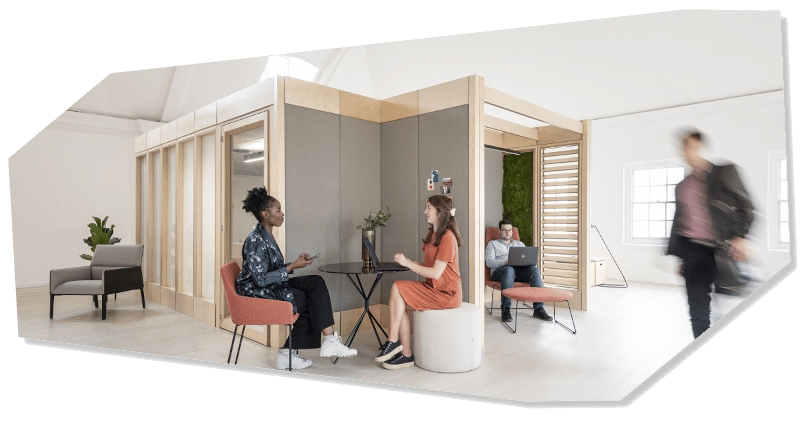Subletting
The most sensible option for those with ongoing grey space is to sublet it. Repurposing unused areas into attractive workspaces for other companies and individuals to lease from you can cover the cost of your surplus real estate – while retaining the freedom to expand and adjust the space in future as you see fit.
The benefits of subletting
There are many advantages to repurposing the growing amount of grey space within offices. Here’s why subletting extra office space is the most tempting option for many:
- Income from subletting can cover real estate expenses
- There is potential for profit
- Stay where employees are comfortable
- Adjust your current office to suit hybrid working
- Futureproof your space with modern refurbishments
- Chance to optimise your current office with space utilisation techniques
- Companies already have remote and hybrid working solutions in place
- No moving fees
- Reclaim the space if you need it back in future
- Increased flexibility for growth
Transforming grey space into attractive offices
Switching up your perspective can make you see surplus office space as an opportunity. Rather than an extra cost setting you back, investing in this space can help you maximise your resources.
While you have the freedom to renovate additional space as you wish, it’s worth focusing on delivering the benefits that prospective tenants will be looking for from their sublet. Here are just a few of the ways you can implement attractive workplace concepts and products within your space.
Selecting your design and build specialists
To bring your workspace solution to life, you need to partner up with workspace refurbishment experts. These design and build specialists can help you navigate your project, ensuring you create a space that ticks all the boxes and offers clients (and your own business) value for money.
Workspace consultancy and space utilisation
Choose an office refurbishment team that can support you throughout your entire project. They should begin by carrying out a workspace consultancy evaluation, noting ways to improve your space with effective solutions to boost productivity.
Space utilisation is a core consideration in optimising your grey space – the more efficient ways you fill your space, the more profit you can generate. Your design and build team will help configure the layout of your new offices, taking into account the current space and state of your grey space and how they can best optimise the area.
Considered interior design
Practicality isn’t the sole factor that makes subleasing office spaces so tempting to businesses and individuals. These workspace solutions are often fit out with enticing interiors that are more affordable for companies to lease than to develop themselves.
Your design and build team will have a portfolio of previous refurbishment projects they’ve worked on. They should help guide the interior design process, incorporating your own input while considering current workspace trends, futureproofed and efficient design solutions – and your budget.
Designed to maximise productivity
It’s not all about how your new workspace looks. Potential tenants will be looking for spaces that enable employees to do their best work. Think about performance-boosting aspects like ergonomic furniture, natural light sources, relaxation spaces.
Considering everything from a human-centred design perspective will ensure your workspaces are places people can thrive. Your clients will be willing to pay more for that luxury, continuously renewing their lease contracts as they notice improved outcomes from the workforce.
Your design and build specialists will be well-versed in merging functional elements within your offices. Adopting successful concepts that we’ve seen across hybrid and agile working environments will be another bonus they can help you achieve. This will help ensure your subleasing project becomes a success.
Efficient shared amenities
Think about the most efficient placement and design of restrooms, break-out areas, cafeterias, meeting rooms and collaboration zones. In co-working spaces, these designated areas offer potential to boost that sense of belonging and connectivity often lacking in those that work alone or in smaller groups.
Even those with self-contained private offices, or individual desks, will want to keep their own things and personal tech in the office overnight. Security-wise, think about how you’ll make this possible. Will you offer designated smart lockers? Where can they be placed for easy access?
Your design and build partner will identify solutions to the issues that arise, combining their workspace consultancy experience with a robust, evidence-based approach to getting the most from the new layout.
Opportunity for personalisation
Companies with well-developed company cultures, or those seeking longer-term lets, will want to inject their own personality into their space. The ability to provide customisable elements within any self-contained offices will enhance their appeal to prospective tenants.
Consider:
- Chalk or noticeboard walls – cost-effective yet fully customisable
- Areas to showcase company values and inject the brand ethos
- Moveable furniture and partitions, modular design
- Elements to support company culture – collaboration zones, wellbeing rooms, recycling systems
- Adjustable lighting, temperature, and acoustic tech – these can be adapted to specific preferences of individuals and teams, giving more control over the working environment
The tech aspect
Any office user will understand the importance of having enough and the right kinds of technology in the workplace, but this crucial element is amplified when we consider how to work around offices designed to be sublet to a range of tenants. How will the provision of WiFi work? What data storage? You will also need to think about how best to provide access to videoconferencing and collaboration technology, bookable resources and rooms, among other things.
Consider placing any ‘sharable’ equipment in accessible communal zones so they can be utilised by more than one tenant. Consider how you’ll facilitate the use of necessary office technology between spaces:
- Printing equipment
- Conferencing tech
- Multimedia systems
- Projectors
- Sit-stand desks
- Interactive smartboards
Each tenant will have varying degrees of reliance on the tech they use – some of them requiring more niche systems and hardware. Think about the more uncommon tech your tenants might require. Will they be required to bring in their own equipment? The ability to provide access to expensive office equipment could be a huge selling point for those smaller businesses who otherwise wouldn’t be able to afford access.
Your design and build team can help you navigate the tech aspect of your new space. They’ll be experienced in advising on the best technology for you to implement, considering how this may impact the future of your office throughout the entire process. Their goal should be to develop a sustainable solution that can evolve, as working habits and requirements continue to change.
In our next blog, we’ll look at how working with property agents can help you sublet your revamped space.
Office workspace can help you optimise your office footprint
At Office Workspace, we’re experts in developing modern office spaces that enhance productivity, creativity and collaboration while reducing costs.
As a multi-generational, family-owned business, we’ve refined our methodology over the years to provide our clients with best-in-class solutions, services and support. As attitudes to the workplace evolve, so do we, and this is reflected in our approach to workspace design. Fusing data-led practicality with our unwavering creative vision, our workspace developments are designed for success.
If you’d like to discuss how our office space solutions could work for you, please call our team on 020 8309 0000. Alternatively, you can get in touch via our online contact form.

